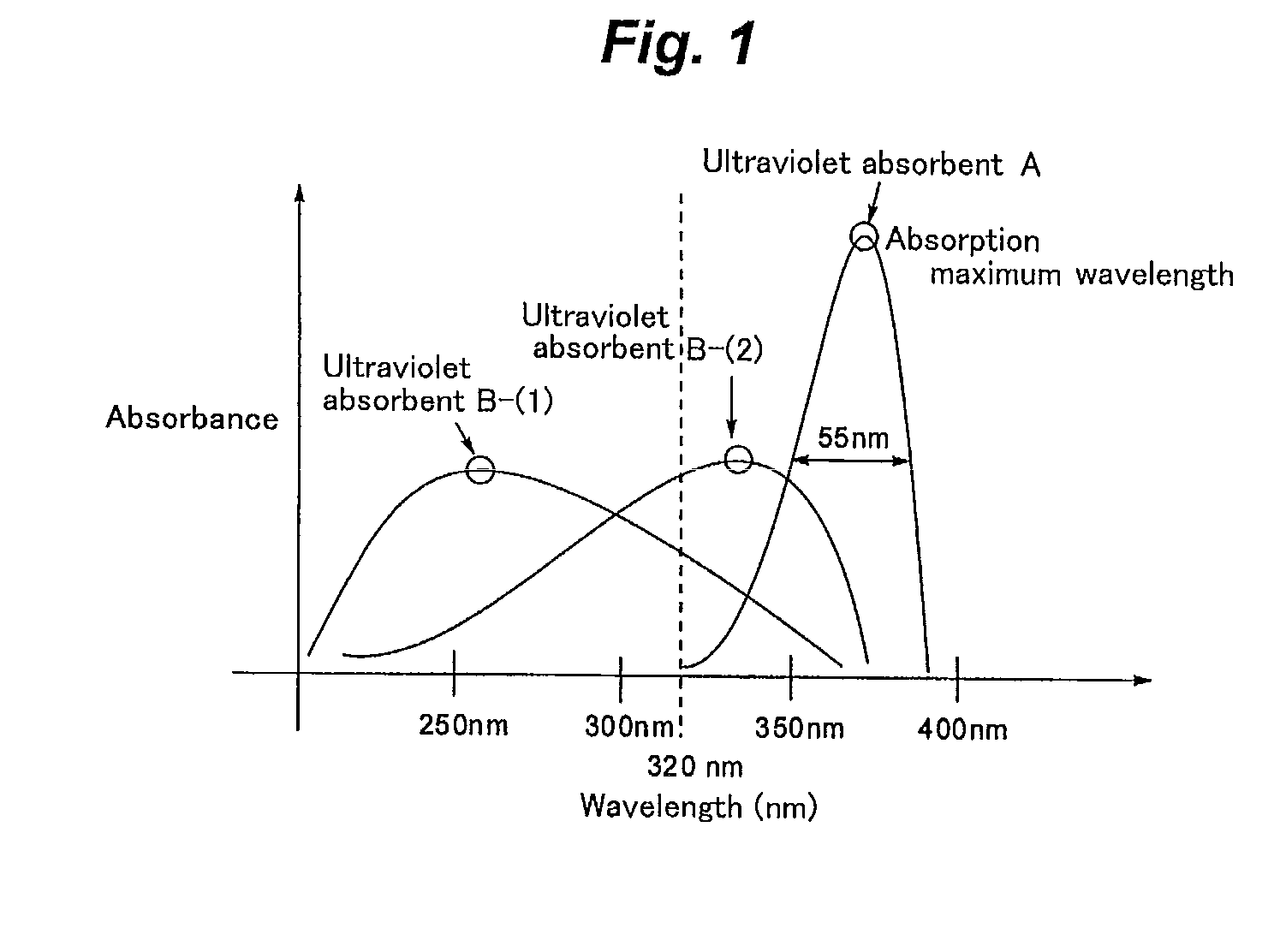Ultraviolet absorbent composition
a technology of absorbent composition and ultraviolet light, applied in the field of ultraviolet light absorbent composition, can solve the problems of bleedout, inability to solve the above problems, increase in addition amount, etc., and achieve the effect of narrowing the absorbent width, sharper spectral shape, and broadening the spectral shap
- Summary
- Abstract
- Description
- Claims
- Application Information
AI Technical Summary
Benefits of technology
Problems solved by technology
Method used
Image
Examples
example 1
Preparation of Ultraviolet Absorbent Composition
[0357]Ultraviolet absorbent composition samples 1 to 45 in combination of ultraviolet absorbents A and B were prepared, as shown in the following Tables 4 and 5. In the following Tables 4 and 5, the ratio of the ultraviolet absorbents A to B(A:B) is expressed by molar ratio.
TABLE 4Formula ofClassificationUltravioletUltravioletUltravioletof UltravioletSampleabsorbent Aabsorbent BA:Babsorbent Babsorbent BRemarks1S-06II-21:1(IIa), (IIb)B-(1)This invention2S-06II-31:1(IIa), (IIb)B-(1)This invention3S-06II-41:1(IIa), (IIb)B-(1)This invention482II-41:4(IIa), (IIb)B-(1)This invention5S-01II-51:1(IIa), (IIb)B-(1)This invention6S-01II-61:1(IIa), (IIb)B-(1)This invention7S-01II-81:1(IIa), (IIb)B-(1)This invention8S-01 II-101:1(IIa), (IIb)B-(1)This invention9S-01II-11:1(IIa), (IIb)B-(1)This invention10S-03II-11:1(IIa), (IIb)B-(1)This invention11S-06II-11:1(IIa), (IIb)B-(1)This invention12S-09II-11:1(IIa), (IIb)B-(1)This invention13S-10II-11:1(IIa...
example 2
Preparation of Molded Plates 101 to 109
[0365]One (1) kg of a polymethyl methacrylate resin (PMMA) and 0.1 g of the composition sample 1 were agitated in a stainless steel tumbler for 1 hour. The mixture was melted and blended by a vent extruder at 230° C. and extruded into pellets for molding by an ordinary method. The pellets were dried at 80° C. for 3 hours, and then, molded into a molded plate 101 having a thickness of 3 mm by an injection molding machine.
[0366]Molded plates 102 to 105 were prepared in a similar manner to the molded plate 101, except that the composition sample 1 was replaced with the composition sample 4, 7, 16, or 18 in preparation of the molded plate 101.
[0367]Alternatively, molded plates 106 to 109 were prepared in a similar manner to the molded plate 101, except that the composition sample 1 was replaced with the composition sample 36, 39, 44 or 45 in preparation of the molded plate 101.
(Evaluation)
[0368]Each molded plate prepared was photoirradiated by a xe...
example 3
Preparation of PET Films 201 to 207
[0371]A transparent coating consisting of 100 g of DIANAL LR-1065 (trade name, manufactured by Mitsubishi Rayon, 40% methylethylketone (MEK) solution of an acrylic resin) and 0.5 g of the composition sample 5 was applied on a 100-μm polyethylene terephthalate (PET) film to be a dry film thickness of approximately 30 μm with a bar coater, and dried to give a PET film 201 having an ultraviolet-absorbing layer.
[0372]PET films 202 to 205 were prepared in a similar manner to the PET film 201, except that the composition sample 5 was replaced with the composition sample 15, 21, 27 or 30 in preparation of the PET film 201.
[0373]Alternatively, PET films 206 and 207 were prepared in a similar manner to the PET film 201, except that the composition sample 5 was replaced with the composition sample 36 or 39 in preparation of the PET film 201.
(Evaluation)
[0374]A solid image in magenta color was printed on an inkjet-recording paper and dried sufficiently by usi...
PUM
| Property | Measurement | Unit |
|---|---|---|
| absorption maximum wavelength | aaaaa | aaaaa |
| absorption maximum wavelength | aaaaa | aaaaa |
| absorption maximum wavelength | aaaaa | aaaaa |
Abstract
Description
Claims
Application Information
 Login to View More
Login to View More - R&D
- Intellectual Property
- Life Sciences
- Materials
- Tech Scout
- Unparalleled Data Quality
- Higher Quality Content
- 60% Fewer Hallucinations
Browse by: Latest US Patents, China's latest patents, Technical Efficacy Thesaurus, Application Domain, Technology Topic, Popular Technical Reports.
© 2025 PatSnap. All rights reserved.Legal|Privacy policy|Modern Slavery Act Transparency Statement|Sitemap|About US| Contact US: help@patsnap.com



